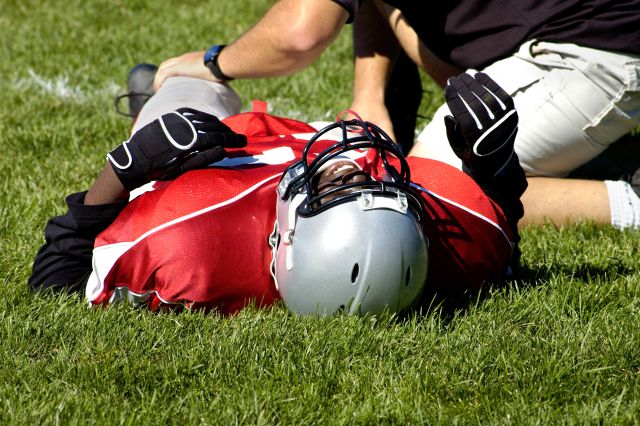Updated on October 29, 2024.
When your child signs up for Little League, you know the chances are pretty good they’ll come home with a bump or bruise that you can treat with a little love and your first-aid kit.
But do you know what to do if something more serious happens? Each year, more than 775,000 million kids ages 14 and younger go to the emergency room for sports injuries, according to the Stanford Medicine Children’s Health and Safe Kids Campaign.
Find out how to keep your student athlete safe this school year with advice from pediatrician Todd Brubaker, DO, a pediatrician in Colorado Springs, Colorado.
Schedule a sports physical
Before your child laces up their cleats or sneakers, make sure they have a sports physical. Ideally, this is conducted as part of a regular annual well visit. “Your doctor will take a detailed account of any previous injuries, medical conditions, and a family history. We also ask about what kind of sports your child will be playing,” says Dr. Brubaker.
Next, a physical exam covers everything “from the top-most hair on your child’s head all the way down to the toes,” says Brubaker. While you’re at the healthcare provider’s (HCP’s) office, it’s also a good opportunity for your child to get up-to-date on routine vaccinations.
Know what to do
Next time your child gets hurt, be prepared. Here are three common sports-related conditions, their symptoms, and treatments.
Sprains and strains
These are the most common types of sports injuries. But what’s the difference between the two?
A sprain is an injury causing stretching or tearing to a ligament in a joint. A strain is an injury that causes stretching or tearing of a tendon or muscle. It’s also known as a “pulled muscle.”
Strains are typically treated with rest, heat, or cold. Physical therapy can sometimes help, too, says Brubaker. For sprains, “rapid physical therapy and the return to range-of-motion exercises is important, because it gets kids moving and back to their regular activities faster than using crutches or bed rest,” he explains. In severe sprain cases, your child’s HCP may suggest surgery based on the location of the sprain and condition of the ligament.
Heat-related illness
“Heat illnesses are best prevented by avoiding being outside during the hottest parts of the day,” says Brubaker. But what if your child has summer workouts, such as August football practices, with intense drills in the sun—and sometimes even two practices a day?
“If there’s a game or practice then,” Brubaker advises, “make sure your child wears loose clothing when possible, sunscreen that protects against UVA and UVB rays, and stays hydrated.” Plain old H20 is fine for activities that last less than an hour. For longer activities, try electrolyte replacements like Gatorade G2 or Pedialyte.
Symptoms of heat exhaustion include weakness, headache, heavy sweating, and cool, clammy skin. In this case, your child should move to a shaded place and rehydrate. Using ice packs or wet towels can help cool the body. If their symptoms don’t improve within 30 minutes, get medical help.
Heat stroke is a life-threatening condition that requires emergency care. Symptoms include hot and dry skin, a high fever, confusion or agitation, and possibly loss of consciousness. If your child shows these signs, they need to get to the ER immediately.
Concussion
A concussion happens when a blow to the head or other part of the body causes the brain to be jostled inside the skull. Concussion symptoms include headache, dizziness, and blurry vision. More severe signs include seizures and worsening headaches, as well as pronounced confusion or abnormal behavior.
If your child has had a possible concussion, have them evaluated by a professional, either on the field or at the ER. Whether they’ll need a hospital stay depends on the severity of the concussion.
The good news: Most concussion cases are mild, and symptoms usually go away after a week. Over time, your athlete can often slowly return to normal activities and sports, once their HCP gives the okay. Experts now recommend returning to school and easing back into light physical activity sooner, as symptoms allow, since both can help speed up healing. But it’s crucial is to never let your child play contact sports—or any activity that could increase their risk for a blow to the head—until they have made a full recovery.
When the sport calls for it—be it baseball, football, hockey, lacrosse, skiing/snowboarding, horseback riding, or cycling—make sure your player has a properly fitting helmet. And remind them that it’s important, and never a sign of weakness, to take themselves out of the game if they’ve bumped their head and are feeling any symptoms.
Coach your child
“Kids are prone to injury because they lack the inherent fear that adults have of getting hurt,” says Brubaker. And while your player may think they’re the next Pat Mahomes or A’ja Wilson, they shouldn’t push themselves beyond reasonable limits.
Raising a young athlete is a team effort that includes the parents, coaching staff, and HCPs all teaching your child the importance of regular, safe sports practice, including strength-training, conditioning, and flexibility.







